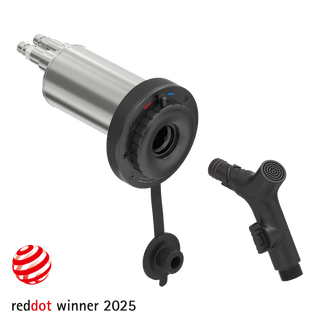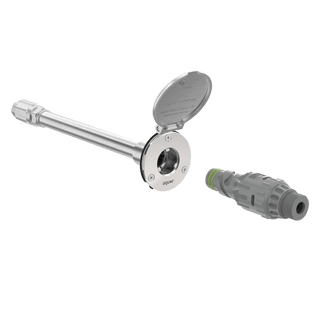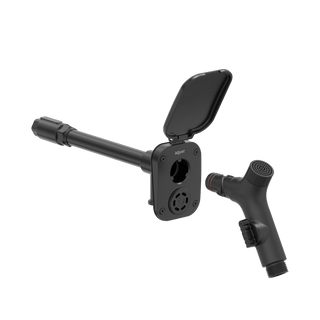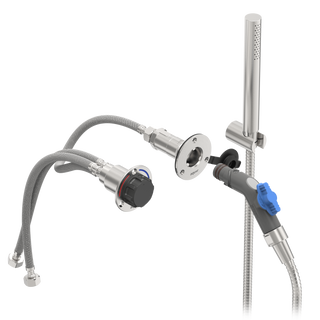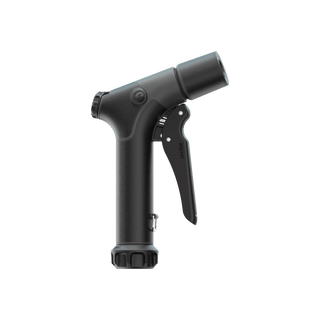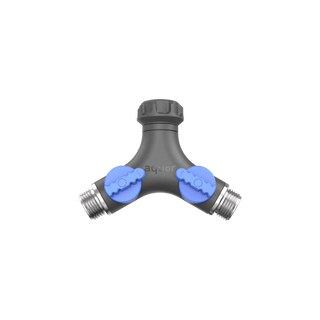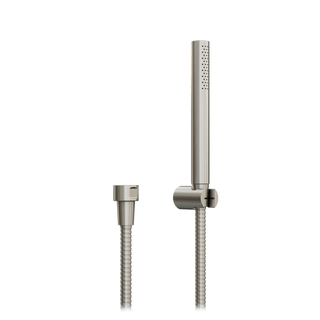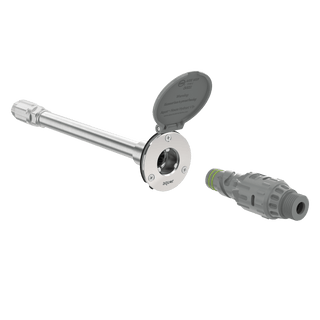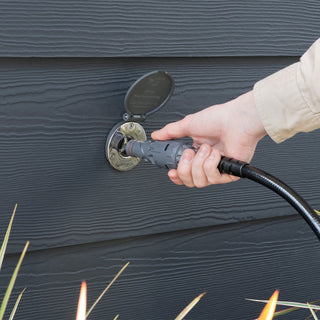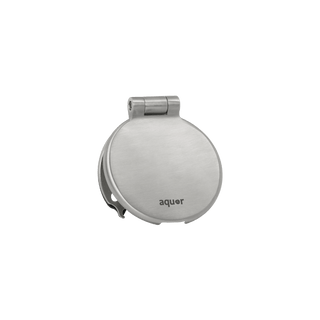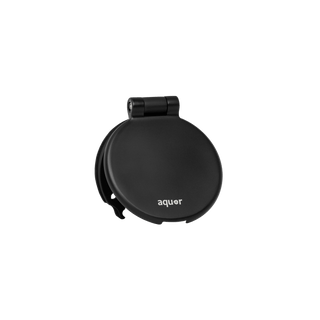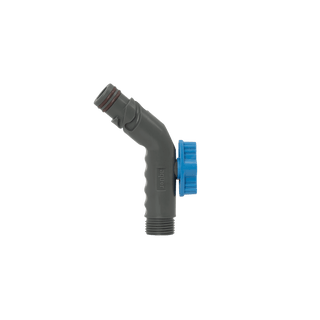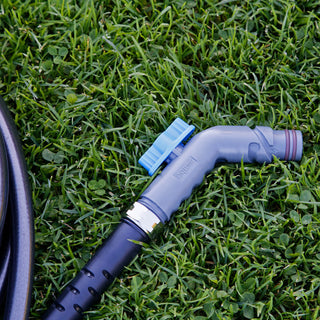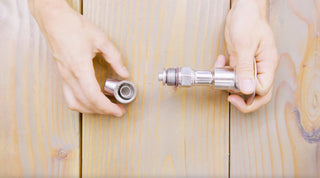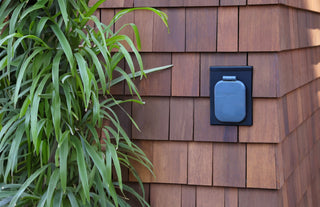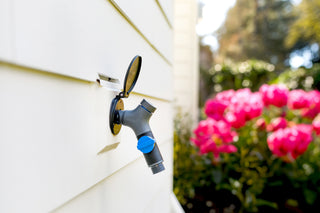Project Highlights: House Hydrant V1 Retrofit Install in Seattle
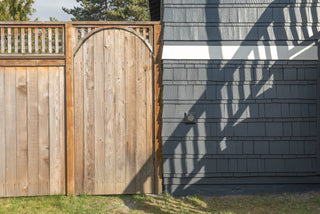
Aquor recently installed House Hydrant V1 hose bibs on a quaint remodel in Seattle, Washington.
The owner is in the process of converting the cedar shingle home into a multi-family dwelling and chose Aquor for the sleek appearance as well as peace of mind—one less thing to winterize later on in the year.
Since a retrofit was necessary, the V1 was an obvious choice. The V1 can easily be swapped in for existing hose bibs, similarly to any new standard sillcock replacement.
The house is plumbed with a combination of the original plumbing, 3/4″ copper, and PEX, which had been added to the plumbing system later. The copper and PEX were joined with SharkBite fittings.
For consistency, the V1 was installed with PEX and SharkBite as well.
First, the water was turned off via the shutoff valve for the house.
 Locate the water shutoff valve, then turn off the water.
Locate the water shutoff valve, then turn off the water.
Then the water was drained from the line outside.
 Unscrew the old hose bib.
Unscrew the old hose bib.
Once the water had drained from the pipes, the old hose bib was unscrewed from the exterior mounting block, the piping was undone, then the old hose bib was removed from the outside of the house.  Remove the old hose bib from the exterior of the house.
Remove the old hose bib from the exterior of the house.
The old hose bib’s entry hole in the mounting block was 1″ in diameter. A larger 1.5″ diameter hole was needed for the V1.  The old brass hose bib vs. a 4-inch stainless steel House Hydrant V1.
The old brass hose bib vs. a 4-inch stainless steel House Hydrant V1.
To enlarge the existing hole, a 4″ long, 1″ diameter dowel with a pilot hole drilled down the center was used as a guide for a 1.5″ hole saw.  For stability, add a 1″ diameter dowel to a 1.5″ hole saw when enlarging the hose bib mounting hole to 1.5″.
For stability, add a 1″ diameter dowel to a 1.5″ hole saw when enlarging the hose bib mounting hole to 1.5″.
In order to create enough room to easily make a 90° join with PEX, 18 inches of the copper water line leading to the hose bib was removed using a motorized cutter.
The V1 was then installed on the exterior of the house—always make sure to put the debris cover behind the Hydrant faceplate.  Place the cover behind the Hydrant faceplate.
Place the cover behind the Hydrant faceplate.
With the mounting holes lined up and the cover level, the mounting holes were prepiloted with a drill.
#10 stainless steel screws were used to secure the V1 into the existing mounting block.  Screw the Hydrant into place.
Screw the Hydrant into place.
Mounting screws are included with the Hydrant and Hose Connector. If longer or shorter screws are needed, use #10 stainless steel screws.
Looking good! Time to make the plumbing connection.  The V1 provides quick and easy water access.
The V1 provides quick and easy water access.
Teflon tape was wrapped around a 1/2″ NPT ProPEX fitting before securing it to the rear of the Hydrant.  Wrap teflon tape around the 1/2″ NPT ProPEX fitting.
Wrap teflon tape around the 1/2″ NPT ProPEX fitting.
Next, a SharkBite 3/4″ to 1/2″ reducing coupler was secured to the vertical copper water line leading down to the Hydrant.
On the Hydrant end, a ProPEX expansion fitting was added to a 6″ length of 1/2″ PEX tubing, then secured to the 1/2″ NPT ProPEX fitting with the help of a ProPEX expansion tool.  A ProPEX expansion tool makes the plumbing connection a snap.
A ProPEX expansion tool makes the plumbing connection a snap.
The 6″ PEX tubing was cut down to line up with the vertical copper water line, then a ProPEX expansion fitting was added to the freshly cut end of PEX tubing before expanding. A 90° elbow ProPEX to ProPEX coupler was attached.
After the 90° elbow was secured, it was time to connect a length of PEX tubing from the SharkBite fitting attached to the ¾” copper water line above to the 90° elbow below.
It took about 10 minutes for all the ProPEX joints to shrink down and set before turning on the water to check for leaks and testing the Hydrant operation.  Testing the new House Hydrant out.
Testing the new House Hydrant out.
Water access made easy!
View the install video, and learn how to replace a standard hose bib with the House Hydrant V1.
Materials and Tools List:
- Plumbing Material
- 1/2″ PEX tubing
- Plumbing fittings
- ProPEX expansion fittings
- SharkBite 3/4″ to 1/2″ reducing coupler
- 1/2″ NPT ProPEX fitting
- 90° elbow ProPEX to ProPEX coupler
- PEX cutter
- Copper cutter (motorized)
- ProPEX expansion tool
- Teflon tape
- Phillips screwdriver
- 1 1/2″ hole saw
- 1″ homemade dowel guide
- Aquor House Hydrant V1 and Hose Connector

